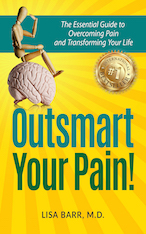Outsmart Your Pain Glossary
(All Definitions adapted from information in the Merriam-Webster dictionary and Wikipedia)

Photo by Chris Lawton on Unsplash
Amygdala– Is part of the brain’s limbic system and is responsible for detecting fear and preparing emergency events. It consists of a pair of almond-shaped masses of gray matter in the front part of the temporal lobe of the brain. It is one of the four basal ganglia and is responsible for storing and retrieving memories.
Biopsychosocial model of health care- is a broad view of disease that takes into account the intricate interaction of biological factors (genetics and biochemical etc.), psychological factors (mood, personality, behavior, etc.) and social factors (cultural, familial and socioeconomic)
Energy work- has it’s foundations in many different ancient healing arts. It can involve the laying on of hands, use of sound and vibration as well as stones, oils and essences. The goals of energy work include; detoxification, relaxation, attunement and clearing of one’s ‘negative’ energy. The treatment centers on uplifting ones energy level. Spiritual healing of all kinds are forms of energy work.
Endorphins– are hormone molecules or neurotransmitters in the brain and spinal cord that produced in response to stress, fear or pain. They interact with receptors in cells , blocking pain and controlling emotion.
Epigenetics– is the study of inheritable changes in gene function that do not involve changes in actual DNA sequences. Epigenetics is the influence of internal and external factors that influence gene expression.
Ergonomics– is an applied science concerned with designing and arranging things that people use at home and at work. Ergonomics helps adapt the environment to people so that people don’t have to adapt to their environment. It is designed to creatively solve challenges of humans interfacing with equipment and technology, so that the people and things interact most efficiently and safely.
Functional MRI– magnetic resonance imaging used to detect physical changes ( such as of blood flow) in the brain resulting from increased neuronal activity from thoughts, emotions and physical actions.
Herniated disc– is a disruption in the outer container of a disc in the cervical (neck), Thoracic (Mid-back) and Lumbar (lower back) portions of the spine allowing protrusion of disc material into the spinal canal that could cause nerve or spinal cord compression or irritation.
Hippocampus– is a curved elongated ridge that extends over the floor of the lower part of each lateral ventricle of the brain. It is part of the limbic system and consists of gray matter and white matter. It is involved in forming, storing, and processing memory and emotion.
Homeostasis-is desirable stable state of equilibrium or ultimate balance within one’s internal environment. It relies on interrelated parts to communicate to form a unified whole.
Hypothalamus– a basal part of the diencephalon that lies beneath the thalamus on each side, forms the floor of the third ventricle, and includes vital autonomic regulatory centers.
Limbic System-is a complex system of nerves and networks in the brain that controls the basic emotions of fear, pleasure, happiness and anger. It is also called the paleo mammalian brain as it supports primitive survival functions including, emotion, behavior, motivation, long term memory and olfaction. The limbic system is made up of the Hippocampus, hypothalamus and the amygdala.
Neural Pathways– are a series of connected nerves along which electrical impulses that travel in the body, firing in predictable patterns.
Neuroscience is a branch (such as neurophysiology) of the life sciences that deals with the anatomy, physiology, biochemistry, or molecular biology of nerves and nervous tissue and especially with their relation to behavior and learning and physical performance.
Neurotransmitters– are substances (such as norepinephrine or acetylcholine) that transmit nerve impulses across a synapse or nerve junction. This is the chemical part of nerve transmission, signaling bodily processes to turn on and turn off. Serotonin and Dopamine as well as Norepinephrine are neurotransmitters that are at least in part responsible in modulating mood and pain threshold.
Osteopathy– is a system of medical practice based on the theory that diseases are due chiefly to loss of structural integrity within the skeleton and soft tissues of the body. Disruption of the skeleton and soft tissues can potentially lead to dysfunction in the organs and can be restored by Osteopathic manipulation of the skeletal dysfunction, thereby improving function of the entire system.
Oxytocin-is a powerful hormone that acts as a neuropeptide in the brain. It is a feel good hormone that plays a role in bonding, love, social interaction, empathy and generosity.
Peptides– are molecules in the body, derived from two or more amino acids that are the building blocks of proteins. Peptides are capable of entering into cells providing instructions to the cells/ tissues about what to do and how to behave. They basically encode information and signal changes in the cells.
Physiatrist– is a physician who specializes in Physical Medicine and Rehabilitation, Pain and physical disabilities.
Physiology-is a branch of biology that deals with the functions and activities of life or of living matter (such as organs, tissues, or cells) and of the physical and chemical phenomena involved therein.
Psychology– is the science of mind and behavior.
Reiki– is an alternative medicine technique originally from Japan that involves the laying on of hands. It is based on our ability to use ‘universal energy’ to encourage emotional or physical healing in ourselves and others.
Psychoneuroimmunology-is a branch of medicine that deals with the influence of emotional states (such as stress) and nervous system activities on immune function especially in relation to the onset and progression of disease. It crosses many different specialties of medicine.
Vagus Nerve– is a pair of nerves (one on the right side of the body and one on the left) called the 10th Cranial Nerves that arise from the brainstem supplying information from the brain to the viscera (GI tract) and also information from the GI tract back up to the brain. It is largely responsible for soothing the fight, flight or freeze response. It is called the wandering nerve because it is the longest nerve in the body.
Zeitgeist- is a concept from 18-19-century German Philosophy that translates as “spirit of the times”. It refers to the invisible force dominating the mindset of the times. One could think of a more contemporary version of it as a defining fad or trend of the times.





